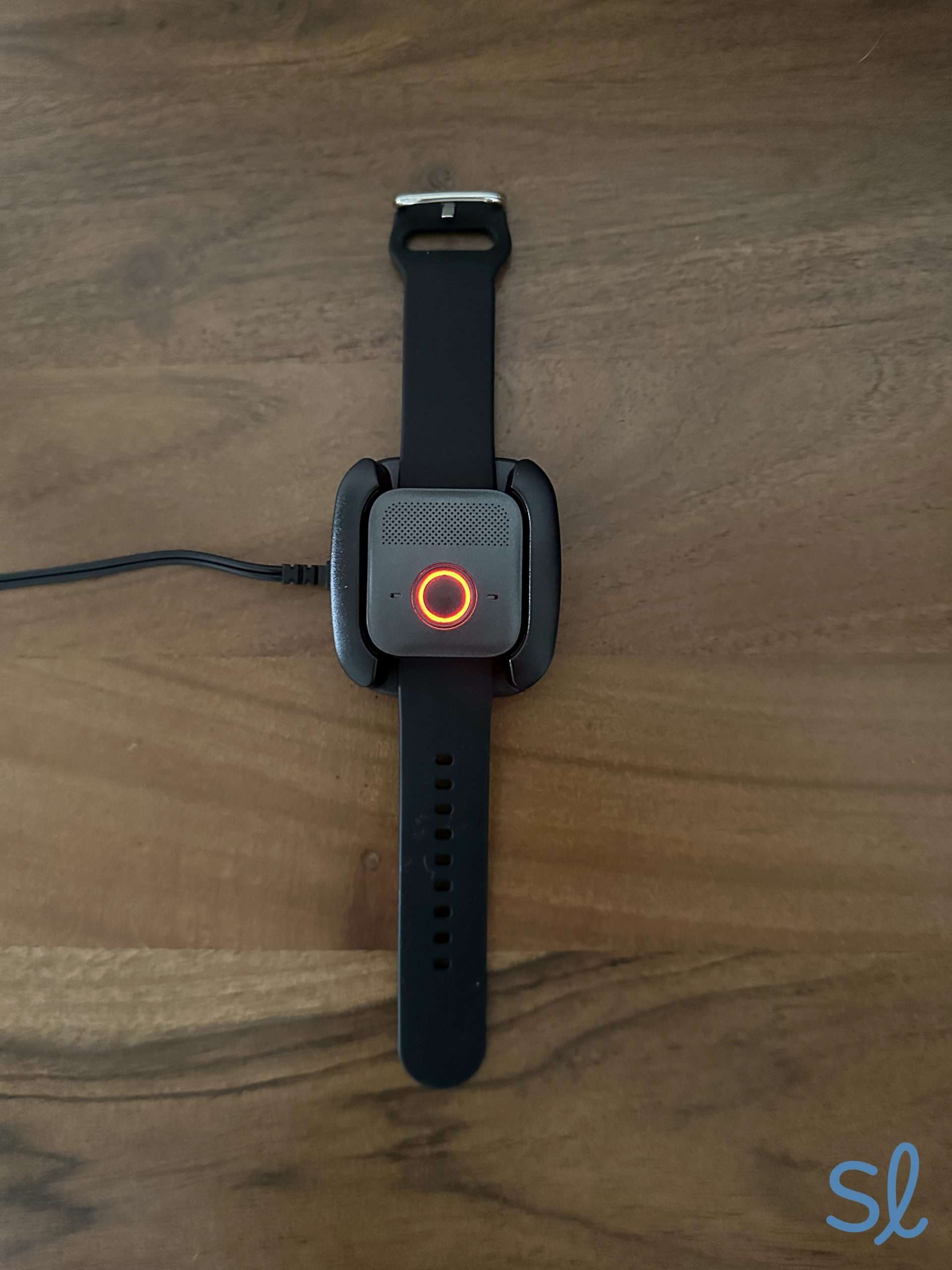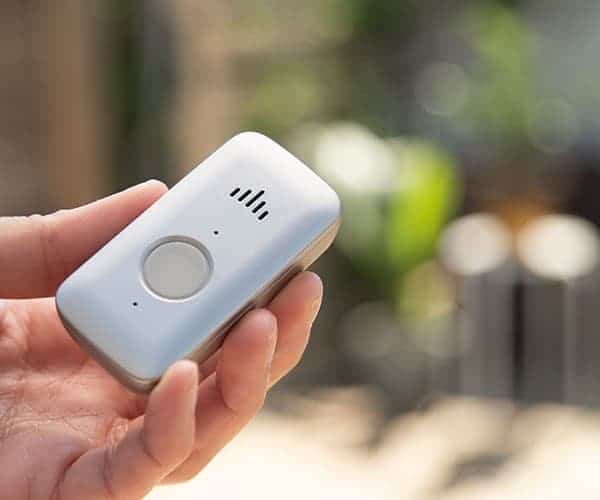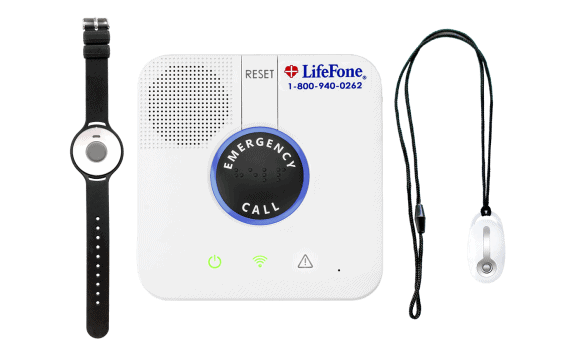LifeFone Medical Alert System Review 2024
LifeFone’s systems are easy to use and offer plenty of options for at-home and on-the-go protection.
SeniorLiving.org is supported by commissions from providers listed on our site. Read our Editorial Guidelines
SeniorLiving.org is supported by commissions from providers listed on our site. Read our Editorial Guidelines
LifeFone’s first medical alert system was launched back in the 1970s, and their products have evolved considerably over the last 40 years. While the medical devices of yesteryear were all tethered to a landline, providers like LifeFone now also offer GPS options that run on cellular networks for more flexibility. LifeFone is recognized by many leaders in senior health, including the American Stroke Association.
For this year’s review, I tested LifeFone’s at-home system, along with the At-Home & On-the-Go, VIP flex package with fall detection. After testing out LifeFone’s products, I give my stamp of approval for usability, price, and transparency (no hidden fees here). Here's everything you need to know about LifeFone rom the sign-up process and discounts to setup and testing.
Pros About LifeFone
- No up-front activation or equipment fees
- User-friendly systems
- Knowledgeable customer service representatives
- Best-in-class warranty
- Lifetime price guarantee
- Affordable fall detection
- Impressive in-home range up to 1,300 feet
- No long-term contracts
Cons About Lifefone
- Best rates require an annual plan
- Add-ons add up (though they are optional)
How Does LifeFone Compare?
LifeFone offers seniors a variety of affordable options for medical alert systems. Plus, with a lifetime price guarantee, you can rest easy knowing that your monthly payments will never go up. But if you want more sleek systems or lower rates, you may want to compare your options. Check out the top providers that we have reviewed.
Overview of LifeFone
The Buying Experience
LifeFone's medical alert systems are easy to purchase through the company’s website or over the phone. I called to see if any discounts were available, and I’m glad I did! I learned that I could receive a free month of service for the package I was considering, and there was a further discount available if I chose the annual payment plan. I also asked about senior discounts, since some other providers offer them. The representative informed me that they have a modest discount for AARP members or veterans. Make sure to call to take advantage of this.
Buyer’s Tip: LifeFone offers a great referral program to help you save. For every customer you refer, you and your referral will receive a free month of service.
The Better Business Bureau1 gives LifeFone an A+ rating, partly based on interactions with customer service. After my interactions with their friendly team (and the very short hold time I experienced on the customer service line), I can see why.
Setting Up My System
For this review, I tested LifeFone’s At-Home Cellular system, along with the At-Home & On-the-Go, VIP flex system. Both systems came in a small box with everything included. The At-Home package came with a base station, wall plug, help wristband, and waterproof pendant (I chose the fall-detection option). The VIP flex system came with a mobile device that looked like a wristwatch, along with a charging cradle and an instruction manual.
At-Home Setup
The At-Home system only took a few simple steps to set up. I plugged in the base unit console, turned it on, and put on the pendant. The base station I tested was the cellular version, which has a digital display that says how many “bars” you have, just like a cell phone. I pressed the button on my pendant, and I was connected to a representative who asked if there was an emergency. I let them know I was just making a test call, and I was set!
At-Home & On-the-Go, VIP flex Setup
To set up the VIP flex unit, I plugged in the charging cradle and placed the mobile unit on it to let it fully charge. Once the mobile unit was charged, I pressed the device’s help button — the only button — to make a test call. After speaking with someone at the response center using the two-way audio, I felt confident that my system was ready and working.
Contracts and Warranty
LifeFone systems have a lifetime warranty, and all of the equipment is covered for normal wear and tear and includes battery replacements at no additional cost. In my experience, this warranty is solid; some other companies we’ve reviewed, like Lifeline, only offer a one-year warranty for select systems. To top it off, LifeFone offers a Protection Plan ($5 per month), which covers damage, loss, or theft. I’d recommend adding it for those who want some extra peace of mind.
LifeFone Systems at a Glance
| LifeFone product | Features | Starting price* | Connection type |
|---|---|---|---|
| At-Home Landline |
|
$29.95 per month | Landline |
| At-Home Cellular |
|
$34.95 per month | Cellular (AT&T) |
| At-Home & On-the-Go, VIP flex |
|
$45.95 per month | Cellular (AT&T or Verizon) |
| At-Home & On-the-Go, VIP Active |
|
$43.95 per month | Cellular (AT&T) |
| At-Home & On-the-Go, VIPx |
|
$45.95 per month | Cellular (AT&T or Verizon) |
| At-Home & On-the-Go Safe Watch Active |
|
$49.95 per month | Cellular (AT&T) |
*Discounts available with quarterly and annual payment plans
LifeFone System and Product Details
LifeFone offers six systems with a wide variety of features and prices. As you evaluate each system below for your needs, we recommend considering the following criteria, listed in order of importance:
- Safety features: Does this system offer all of the essential safety features you want, such as fall detection or 24/7 monitoring?
- Price: Does this system fit your budget?
- Ease of use: Does this system seem like something you will actually use? Or is it too complicated?
- Extra features: Does this system offer the additional features that you want, like caregiver monitoring, a sleek design, or health tracking?
At-Home Landline
 Cost
Cost
Starting at $24.95 per month with an annual payment plan, this at-home system is LifeFone’s most affordable package. There are a few cheaper options on the market — MobileHelp’s prices, for example, start at $19.95 per month for in-home coverage — but LifeFone is still decently priced. You also can get a $2 monthly discount if you pay quarterly or a $5 discount if you pay annually.
There are no activation or equipment fees, and you can add automatic fall detection for $5 per month, which is inexpensive for fall detection. For comparison, Medical Guardian’s fall detection costs $10 per month, a pretty standard price for the industry.
Equipment
The At-Home Landline system comes with a base station with a 32-hour backup battery in case you lose power and a wearable help button. The base unit has a high-output speaker and a sensitive microphone for clear two-way communication. The wearable help button allows you to call for help anywhere in the 1,300-foot base-to-button range, so there’s no rush to get to the phone or base station.
Did You Know? LifeFone made our list of this year’s best medical alert providers.
This at-home system offers a few unique features that I like. If you have a home phone connected to your landline, you can answer calls using your LifeFone system. Simply press your wearable help button when you hear the landline phone ring. The base unit also has a built-in temperature sensor. If the temperature is out of the norm, the system will automatically send an alarm.
Service and Monitoring
At-Home Landline is for those who (you guessed it) have a landline. It’s also my pick for older adults who spend a lot of time at home or are on a tight budget. In an emergency, just press your wearable button or the help button on the base unit. The system will connect you to a live operator who can dispatch the right help for the situation. LifeFone’s monitoring center is available 24/7, so you’ll be covered at all times.
At-Home Cellular
Cost
At $34.95 per month, the system is $5 more than the landline option. You’ll pay $32.95 per month with a quarterly plan or $30.95 per month with an annual plan. Like the rest of LifeFone’s systems, there are no activation or equipment fees. You can also add fall detection for $5 per month.
Equipment
At-Home Cellular is essentially the same system as the landline option, with a base station and wearable help button. The main difference is that it doesn’t require a landline. The base station has a room-temperature sensor that sends an alarm if your home temperature falls below or rises above your customized settings. It also features optional caregiver tools, like daily check-in calls, which are great for caregivers who want to keep a closer eye on the user.
Service and Monitoring
LifeFone’s At-Home Cellular is excellent for those who like to spend a lot of time at home. This system doesn’t use a landline; it operates on AT&T’s cellular network. You don’t have to be a current AT&T customer to use it, because LifeFone provides the AT&T service. If you live in an area with reliable AT&T coverage and don’t have a landline, At-Home Cellular is a good option. If there isn’t solid coverage in your area, I’d recommend going with the landline system to save a few bucks.
At-Home & On-the-Go, VIP flex
Cost
At $45.95 per month, VIP flex costs just a few dollars more per month than the VIP Active LifeFone system, but the design is much more convenient to wear. (You can wear the VIP flex as a watch, belt, or pendant. More on that below.)
You can add fall detection for $5 more per month, and there are no activation or equipment fees. If you decide to cancel your subscription, you can do so at any time and you’ll pay only for the amount of time you’ve used the service.

Charging LifeFone's VIP flex system
If you want to save money and plan to use VIP flex long-term, consider a quarterly or annual plan. VIP flex costs $45.95 per month when paid monthly. When you pay quarterly, however, you’ll pay the equivalent of $43.95 per month and your fourth month is free. Paying annually will save you even more. Your price will drop to the equivalent of $41.95 per month, and your 12th month is free. The quarterly and annual plans come with free shipping, and the annual plan also includes a free lock box. Talk about a deal!
Equipment
According to LifeFone, VIP flex is its smallest, lightest, and most versatile mobile alert device. You can wear it on a wristband, your belt clip, or a necklace as a pendant. If you want to wear it on a wristband, you’ll need to purchase the wristband separately. LifeFone doesn’t currently sell the wristbands, so you’ll need to buy one from a different retailer.
The battery lasts for up to five days, but adding fall detection may reduce the battery life. You can easily recharge the battery by putting the device on the cradle. LifeFone alerts you when your battery is running low with a text and email reminder, so you can plan ahead to charge the device.
The VIP flex is a small, discreet device at 1.57 inches tall and 0.7 ounces. It’s water resistant, which means you can wear it in the rain or shower. Its black color will coordinate well with outfits, and it has a more modern look than the LifeFone VIP Active pendant. The option to wear the VIP flex on your belt or as a watch gives you more versatility too.
Service and Monitoring
The VIP flex is a great choice for anyone looking for extra peace of mind when they’re alone, whether they’re working in the yard or spending time in the house. The device is equipped with advanced location technology, allowing you to summon help by pressing the single button to contact LifeFone’s U.S.-based call center. The call center can use the device’s cellular, Wi-Fi, and GPS technology to identify your location. The device uses either AT&T or Verizon cell signals, so you’ll be covered on the go.
Buyer's Tip: Want to compare providers that offer fall detection? Visit our list of the best medical alert systems with fall detection.
At-Home & On-the-Go, VIP Active®

Our Editor Jeff Hoyt with the LifeFone Voice-in-Pendant system
Cost
This system costs $43.95 per month, and you can save a few dollars if you choose the quarterly or annual payment plan. You’ll pay $5 per month if you add fall detection.
Equipment
The Voice-in-Pendant Active system is a convenient, all-in-one wearable unit. Everything you need is built right into the pendant, so all you have to do is wear the necklace wherever you go. The black pendant features a two-way speaker and offers vibration feedback to help those with vision or hearing loss. This system has up to a five-day battery life. If you have a hard time remembering to charge your devices like I do, this is a major selling point.
Service and Monitoring
This system is as streamlined as it is low-maintenance; it works through LifeFone’s AT&T cellular network. The necklace is equipped with Wi-Fi and GPS location technology, so help can be sent straight to you, and caregivers can quickly access your location through a text to LifeFone or the LifeFone mobile app.
At-Home & On-the-Go, VIPx®
Cost
The At-Home & On-the-Go, VIPx® costs $45.95 per month. Although a few dollars more than a comparable system from another brand, keep in mind that LifeFone does not charge an equipment or activation fee, and fall detection only costs $5 per month rather than $10, the price you will find from most other brands.
Equipment

LifeFone's VIPx system
The “x” in VIPx® is definitely there for a reason. Compared to the VIP Active®, this system has lots of extras. First, the device is tiny and featherlight, only weighing 1.3 ounces. It also comes in three different colors: black, white, and silver. And, the battery life is up to 10 days, which means that you don’t need to worry about charging it every day.
Service and Monitoring
Like the VIP Active®, you can choose a VIPx® unit that runs on Verizon or AT&T’s cellular network. Location tracking is available and is considered advanced, as it uses both Wi-Fi and GPS to pinpoint a user’s location. Finally, this all-inclusive system offers optional fall detection for $5 per month (through a pendant) and a caregiver’s app loaded with additional functions.
At-Home & On-the-Go Safe Watch Active
Cost
The Safe Watch Active costs $49.95 per month, making it one of the company’s more expensive systems. Similar to LifeFone’s other systems, you can score a discount if you pay for your system quarterly or annually. You can also add fall detection for $5 per month.
Equipment
The Safe Watch Active is LifeFone’s smartwatch system. It is sleek and discreet, with a black face and band and your choice of an analog or digital display. It is chock-full of features, including a step tracker, heart monitor, weather app, two-way talk, and vibration feedback. The watch’s battery lasts up to 24 hours for all-day use. It even has a low-battery warning to remind you when it’s time to charge the device.
For comparison, Bay Alarm Medical offers the SOS Smartwatch, but the battery only lasts up to 18 hours per charge compared to LifeFone’s 24 hours. Fall detection costs $10 per month with Bay Alarm, which is twice as much as LifeFone charges. You’ll also pay a $159 equipment fee for Bay Alarm Medical, whereas LifeFone has no equipment fees.
Service and Monitoring
The Safe Watch Active runs on AT&T’s cellular network. In addition to advanced location tracking, it also offers optional fall detection, which is a rarity among other medical alert smartwatches.
Add-On Features and Accessories
LifeFone offers a ton of add-on services and accessories, which can be daunting. Here are a few of my favorites to consider.
- Activity Assurance caregiver tool ($6 per month): To help with daily check-ins, this tool allows a caregiver to pick a custom check-in time for the user. If the user doesn’t call within 15 minutes of that time, LifeFone will call them.
- Fall detection ($5 per month): I’d highly recommend this add-on if it fits in your budget. The fall detection pendant will automatically sense a fall and call for help, even if you can’t press your help button.
Here are some of the other useful add-on services available:
- Daily check-in calls ($19 per month): With this service, a LifeFone agent will call and check in with you daily and provide medication reminders if needed.
- Location services (free for select systems): Caregivers and family members can access your location through an online portal.
- Protection Plan ($5 per month): Protects you from needing to spend several hundred dollars on a new system if yours is lost, damaged, or stolen.
- VIPx Caregiver App ($8 per month): Allows caregivers to be alerted to the first motion of the day, check the button press history, and more.
- Mobile Alert App: For those who do not want to use a medical alert device. It works on the user’s cellular network.
And here are some additional add-on products:
- Lockbox: You can store an extra key outside your door in this box so first responders can easily access your home without breaking down your door.
- Wall-mounted help button: This button adheres to a wall or surface for extra protection in high-risk areas like the bathroom or stairs.
- Vanity pendant: You can spruce up the design of your pendant with this stylish necklace.
As I said, this many add-on options can be overwhelming. I’d recommend chatting with a LifeFone representative to learn more and help you choose the right accessories for your needs.
LifeFone Medical Alert Video Review
There is a lot of material about LifeFone’s lineup of products and services in this review, but seeing is truly believing. You can check out my hands-on experience with LifeFone’s product in the video below. You’ll also get to see what the devices look like and how they function in real time. Take a moment to watch before you make your final decision on which medical alert device to purchase.
The Bottom Line on LifeFone
ILifeFone is a solid choice for a medical alert device. The company’s systems offer the essential features you need to stay protected, including fall detection, wide coverage ranges, 24/7 monitoring, and caregiver tools. With lifetime warranties, no upfront costs or activation fees, and seasonal discounts, there is an option for most budgets. You’ll also have a 30-day money-back guarantee, which I appreciate. While there are some higher-tech systems on the market, LifeFone is still an excellent option in my book.
Our Methodology
Want to know how we rate and review medical alert providers? It all starts with researching the provider until we have a thorough understanding of their product offerings. Then, we test the systems out for ourselves whenever we can and rate them for several criteria. This criteria includes price, value, ease of use, response times, customer service experience, available features, and more. We then use our experience with the systems to give every provider a star rating. This allows our readers to easily compare and contrast their options. To learn more about our review process, head to our medical alert system methodology guide.
Frequently Asked Questions About LifeFone
-
How much does LifeFone cost per month?
Pricing varies by the product you go with and how you pay for service. Prices start as low as $24.95 per month when you pay annually and range up to $49.95 paid monthly for top-tier packages.
-
What is the return policy for LifeFone?
LifeFone allows you to cancel service at any time, for any reason. There are no long-term contracts, and you will receive a refund if you paid for your service in advance.
-
What happens if I push the button and I’m not able to communicate?
If you push the button and LifeFone’s care agent can’t hear you, they will call your home phone. If they can’t reach you there, they’ll follow your previously provided emergency care instructions and dispatch emergency services to your location.
-
Can I take my device with me when I go on vacation?
Regardless of how long you will be relocating, all it takes to change your system’s location for a vacation is a simple phone call to LifeFone’s emergency response center. If you use the At-Home Landline system, you just need to make sure your new location has a landline.
Better Business Bureau. (2021). LifeFone.






 Cost
Cost